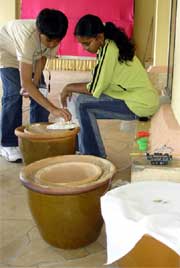Pot-in-Pot Refrigerator
How Does Nature Do It? |
Mohammed Bah Abba is a teacher from rural northern Nigeria. He won the 2000 Rolex Award for Enterprise for his invention of a simple cooling system that can help preserve food in areas where there is no electricity. In this pot-in-pot system, a smaller clay pot is put inside a larger one. The two are separated by a layer of sand, which is kept moist at all times. Evaporation causes the inner pot to stay notably cooler than the outside pot. With Abba’s system, vegetables such as eggplants stay fresh for 27 days, instead of the usual 3, while tomatoes and peppers last for up to 3 weeks.
What To Do
 |
At a November 2006 SEED workshop in Malaysia, we decided to try this for ourselves. We also replicated the experiment later with different pots. Tools and Materials
|

 1. The smaller pot should fit inside the larger one with a space of 1 to 3 cm (0.5 to 1.25 in) between. If the pots have holes in the bottoms, as flowerpots usually do, plug the holes with clay, cork, or some other nonporous substance. This prevents the sand from running out of the larger pot and keeps water from flowing into the inner pot.
1. The smaller pot should fit inside the larger one with a space of 1 to 3 cm (0.5 to 1.25 in) between. If the pots have holes in the bottoms, as flowerpots usually do, plug the holes with clay, cork, or some other nonporous substance. This prevents the sand from running out of the larger pot and keeps water from flowing into the inner pot.
2. Put a small amount of sand into the larger pot. The layer should be thick enough so that when you put the small pot inside the larger one, the tops of the two pots are at the same level.
3. Fill the space between the pots with sand.

4. Pour water on the sand until it is wet to the touch.

5. Dampen the cloth and cover the inner pot.

 6. Use the thermometer to check the air temperature and the temperature inside the pot at fairly regular intervals for a number of hours. We checked an average of every 15 minutes for the first 3 hours and made a final check 13 hours after we started. Note your results in a chart like the one below.
6. Use the thermometer to check the air temperature and the temperature inside the pot at fairly regular intervals for a number of hours. We checked an average of every 15 minutes for the first 3 hours and made a final check 13 hours after we started. Note your results in a chart like the one below.
7. If you have a GoGo Board, click here to find out how to use it with the pot-in-pot refrigerator.
|
Time interval |
Temperature inside pot (degrees Celsius) |
Air temperature outside pot (degrees Celsius) |
|
Initial: |
|
|
|
|
|
|
|
|
|
|
|
|
|
|
|
Final: |
|
|
This content has been re-published with permission from SEED. Copyright © 2025 Schlumberger Excellence in Education Development (SEED), Inc.
Course:

